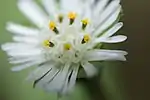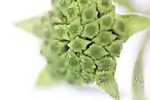| Eclipta prostrata | |
|---|---|
_flower.jpg.webp) | |
| Scientific classification | |
| Kingdom: | Plantae |
| Clade: | Tracheophytes |
| Clade: | Angiosperms |
| Clade: | Eudicots |
| Clade: | Asterids |
| Order: | Asterales |
| Family: | Asteraceae |
| Genus: | Eclipta |
| Species: | E. prostrata |
| Binomial name | |
| Eclipta prostrata | |
| Synonyms | |
|
Synonymy
| |
Eclipta prostrata, commonly known as false daisy, yerba de tago, guntagalagara aaku, Karisalankanni, and bhringraj, is a species of plant in the family Asteraceae. It is widespread across much of the world.[3][4][5]
This plant has cylindrical, grayish roots. Solid, circular, purplish stems with white fine hairs 0.8m. Leaves arranged in opposite pairs, hairy in two-sided, lanceolate, serrated 2–12.5 cm long, 5-35 mm wide. The solitary flower heads are 6–8 mm (0.24–0.31 in) in diameter, with white florets. The bumpy achenes are compressed and narrowly winged.[6]
This species grows commonly in moist places in warm temperate to tropical areas worldwide. It is widely distributed throughout India, Nepal, China, Thailand, Bangladesh and Brazil.
Traditional uses


_01.jpg.webp)
The plant has traditional uses in Ayurveda. In India, it is known as bhangra or bhringaraj. Wedelia calendulacea is known by the same names, so the white-flowered E. alba is called white bhangra and the yellow-flowered W. calendulacea is called yellow bhangra.[7]
In Southeast Asia, the dried whole plant is used in traditional medicine,[8] although there is no high-quality clinical research to indicate such uses are effective. The Balinese cook it as a vegetable, the Javanese consume this herb (orang-aring or urang-aring) as part of their lalap, they also infuse it with coconut oil as a kind of hair oil popular until the 1970s[9] Its leaves are extracted as a black hair dye, and in tattooing.[10]
Phytochemistry
Eclipta prostrata contains various phytochemicals, such as coumestans, polypeptides, polyacetylenes, thiophene derivatives, steroids, sterols, triterpenes, and flavonoids.[11]
References
- ↑ Lansdown, R.V.; Beentje, H.J. (2017). "Eclipta prostrata". IUCN Red List of Threatened Species. 2017: e.T164051A121894451. doi:10.2305/IUCN.UK.2017-3.RLTS.T164051A121894451.en. Retrieved 19 November 2021.
- ↑ "Eclipta prostrata (L.) L." The Plant List version 1.1. Retrieved 26 January 2014.
- ↑ Flora of North America, Eclipta Linnaeus, Mant. Pl. 157, 286. 1771.
- ↑ Flora of China, 鳢肠 li chang Eclipta prostrata (Linnaeus) Linnaeus, Mant. Pl. 2: 286. 1771.
- ↑ Altervista Flora Italiana, Falsa margherita , false daisy, tattoo plant, Eclipta prostrata (L.) L.
- ↑ Steenis, CGGJ van (1981). Flora, untuk sekolah di Indonesia. PT Pradnya Paramita, Jakarta. pp. 423-424
- ↑ Puri, H. S. 2003. Rasayana: Ayurvedic Herbs for Longevity and Rejuvenation. Taylor & Francis, London. pages 80–85.
- ↑ Nantana Sittichai; Chayan Picheansoothon, eds. (2014). Herbal Medicines Used in Primary Health Care in ASEAN. Department for Development of Thai Traditional and Alternative Medicine. pp. 148–149. ISBN 9786161122119.
- ↑ Heyne, Karel (1987). Tumbuhan Berguna Indonesia, vol. 3: p. 1833. Yayasan Sarana Wana Jaya, Jakarta
- ↑ Jukema, J., N.Wulijarni-Soetjipto, R.H.M.J. Lemmens & J.W.Hildebrand (1991). Eclipta alba (L.) Hassk. Archived 2016-03-04 at the Wayback Machine Internet Record from Proseabase. Lemmens, R.H.M.J. and Wulijarni-Soetjipto, N. (Editors). PROSEA (Plant Resources of South-East Asia) Foundation, Bogor, Indonesia
- ↑ Chung, I. M; Rajakumar, G; Lee, J. H; Kim, S. H; Thiruvengadam, M (2017). "Ethnopharmacological uses, phytochemistry, biological activities, and biotechnological applications of Eclipta prostrata". Applied Microbiology and Biotechnology. 101 (13): 5247–5257. doi:10.1007/s00253-017-8363-9. PMID 28623383. S2CID 9288894.
Further reading
External links
 Media related to Eclipta alba at Wikimedia Commons
Media related to Eclipta alba at Wikimedia Commons Data related to Eclipta prostrata at Wikispecies
Data related to Eclipta prostrata at Wikispecies- Jepson Manual Treatment, University of California
- United States Department of Agriculture Plants Profile

